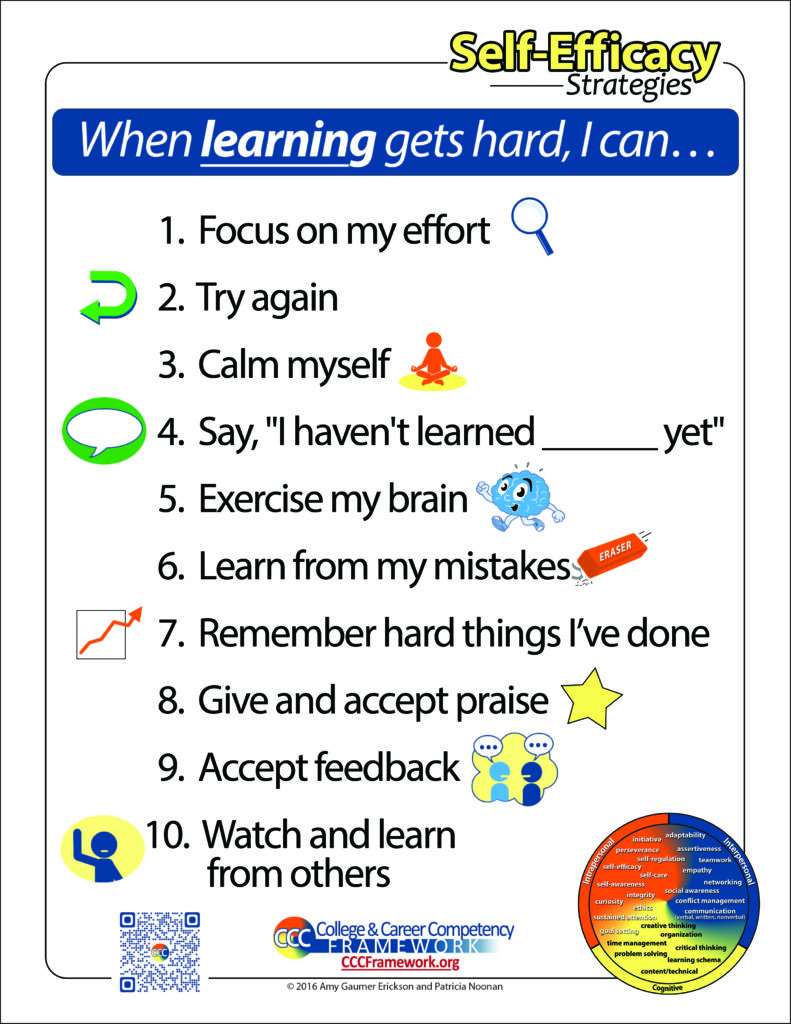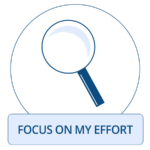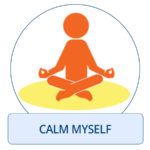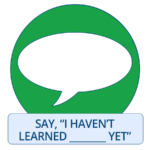Does your child struggle with believing they can learn something challenging? Maybe they give up easily or say things like “I can’t do this” or “I will never be good at this!” Learning Self-Efficacy Strategies can increase your child’s confidence and help them as they experience difficulties in learning new things.
Definition
Self-efficacy is an individual’s perceptions about their capabilities to perform at an expected level, achieve goals, and complete moderately challenging tasks (Gaumer Erickson & Noonan, 2018).
Students use Self-Efficacy Strategies to persist in learning.
Student Impacts
Teachers providing self-efficacy instruction and classroom practice observe student growth, including:
- Increased self-reflection and self-awareness
- Increased belief that ability grows with effort
- Improved confidence in their own abilities
- Improved quality and timeliness of work
- More openness to constructive feedback
Research in elementary and secondary education identifies proven student impacts from teaching self-efficacy.
- Students with stronger self-efficacy will engage more, work harder, and persist longer when they encounter difficulties (Zimmerman, 2000).
- Of many factors, self-efficacy has “the strongest positive and significant association” with life satisfaction (Moksnes et al., 2019, p. 226). It also helps to counteract many stressors, including peer pressure, school/leisure conflict, and school performance.
- By receiving explicit instruction in self-efficacy, students increase their interest in pursuing challenging careers (Falco & Summers, 2019).

Learning self-efficacy from an early age helps children to focus on effort and improve confidence in themselves, and this increases their persistence and sense of accomplishment.
Watch the one-minute video What Is Self-Efficacy? with your child to learn more about what self-efficacy is and why it is important. Afterward, share examples of times when you didn’t feel confident and gave up rather than trying again. Ask your child to describe situations where they have experienced low self-efficacy, using these questions:
- When have you felt like giving up instead of continuing to try to learn something?
- Why do we sometimes feel like giving up instead of trying again?
- Describe a time when you didn’t give up and you learned something that was difficult. What did you say to yourself? What did you do?
Explain that you are going to help them learn Self-Efficacy Strategies so they can understand ways to keep trying when learning gets hard.
These four Self-Efficacy Strategies will help your child believe in their abilities: focus on my effort, try again, calm myself, and say, “I haven’t learned _____ yet.” Additional strategies are explained on the intermediate and secondary parent guidance.

Focus on My Effort
Children need to make the connection between putting forth effort and making progress. When they understand that putting forth more effort will increase their progress, they start to address challenges they experience. Understanding what effort is and what it feels like when they are using effort helps your child understand how to focus on their effort.
Explain that believing you can do hard things starts with focusing on your effort. Effort means trying really hard and using a lot of energy. The energy can come from our bodies working hard or our brains working hard.
Provide a personal example of something challenging you eventually accomplished. Describe how you felt and what you were thinking when you began. Emphasize that you used effort (i.e., tried really hard) and didn’t give up even when you felt frustrated. Then ask your child to remember a time when they were frustrated because they couldn’t do something:
- How did it feel?
- What did you say to yourself? What did you do?
Watch the video Focus on My Effort and discuss what it feels like when you try really hard:
- What is your brain doing when you are focused on your effort?
- What is your body doing when you are focused on your effort?
- When have you focused on your effort to learn something?
Ask your child to identify something they would like to learn or improve by focusing on their effort—for example, improving their ability to play a sport, read, or complete their chores. Divide a sheet of paper in half, and on one half of the paper, ask them to draw what it will look like while they are focusing on your effort to learn or do a challenging task. They might draw themselves practicing basketball or reading a book for twenty minutes. On the other half of the paper, ask them to draw a picture of what it will look like when they accomplish the task. They might draw themselves making a basket or receiving a reading award. Post the drawing and routinely ask your child to reflect on their effort, what they have done to focus on their effort, and how much progress they have made.
Support your child in practicing the strategy focus on my effort by discussing challenging things they are learning at school and the amount of effort they are using. You can use the Effort Meter to guide your discussions. Ask them to rate their level of effort based on the meter and discuss how they could increase their effort.
As you notice characters in books or sports figures putting forth effort, discuss their progress and what they did to focus on their effort. Remind your child that they will likely experience difficulties in school, when learning a new sport, or when practicing a musical instrument. Tell them that, by focusing on their effort, they are learning to keep trying and overcoming their fear that they can’t do something.

Try Again
The second strategy you can use to help improve self-efficacy is try again. If children understand that learning new things requires multiple attempts, they’re less likely to become discouraged when they don’t get something correct on the first try.
Tell your child that you will help them learn how to try again when they encounter challenges. Watch the video Try Again and use these questions to guide your discussion on why trying again is important:
- Why is it important to try again when you are learning something?
- What would happen if you didn’t try again when you were learning?
Ask your child to think about something they recently learned to do by trying again. Point out how hard it was at first but how much easier it got with each new try. For example, learning to ride a bike required many tries. With each try, they thought about what they could do to stay on their bike longer, like pedaling faster or controlling the handlebars better.
Next, ask your child to identify something they wanted to learn but gave up instead of trying again. Ask:
- Why do you think you didn’t try again?
- What would have happened if you had tried again?
Emphasize that we all experience difficulties but it’s how we choose to respond to those difficulties that impacts our ability to complete a task. Watch the video I Choose to Try Again, by Elizabeth Estrada, about a girl who doesn’t want to try again. Her friend gives her some very important advice, including actions she can take to try again. Tell your child to listen for the advice and actions they can take when trying again is difficult. Afterward, ask:
- Why was the girl in the video afraid to try again?
[Possible responses: she didn’t want people to laugh at her; she didn’t want to take the time to learn.] - What are a few things her friend told her to do?
[Possible responses: she should get back up and build her brain muscles; she can say positive things; she can choose to try again.]
Ask your child to tell you about something hard they’re learning. Maybe it’s a new subject, a new sport, or rules at a new school. Remind them that learning new things takes effort and many attempts before they can do it. Show your child the short video Try Again, a musical version of the poem “Try, Try Again,” by T. H. Palmer. As your child learns new things and completes challenging tasks, encourage them to recite the song.
Support your child in practicing the strategy try again by reminding them that success doesn’t usually happen on the first attempt. Share your own examples of what you are learning to do by trying again. If your child has older siblings or peers, point out that they also have to try again when learning things. Ask them to share what they did to try again.

Calm Myself
One reason children lack self-efficacy is because they struggle with managing their emotional reactions. When they experience a challenge, they can become overwhelmed or frustrated and express those emotions by crying, throwing objects, or pulling away from others. When children learn how to recognize and work through emotions, their confidence grows in their ability to face and overcome challenges.
Tell your child that you are going to teach them how to manage their big feelings by using the strategy calm myself. Explain that when we feel nervous or frustrated, our body sends us signals to let us know we are having big feelings—you might have butterflies in your stomach, sweaty palms, shaky hands, or a racing heart. When these things happen, you don’t want them to get in the way of learning or accomplishing something, so you need to do things to calm yourself. Discuss different situations where they might have experienced signals from their body:
- Tell me about a time when you had butterflies or a racing heart.
- Why do you think you felt that way? What did you do?
Watch the video Calm Myself. Afterward, ask:
- What does it mean to calm yourself?
- What are some things you can do to calm yourself?
Encourage them to use the strategy calm myself when they start to feel intense emotions. Rainbow breathing can be used as part of the strategy calm myself. Taking deep breaths will help your child calm their emotions and give them better focus when they are experiencing a challenge.

Say, “I Haven’t Learned _____ Yet”
The next strategy that will build self-efficacy in your child is say, “I haven’t learned _____ yet.” When there is something they can’t do or are struggling to understand, it is because they haven’t learned it yet. Explain that when we are working to learn something, making mistakes, and feeling discouraged, we should say, “I haven’t learned this yet.”
Watch the video Say, “I Haven’t Learned It Yet!” Afterward, share some examples of things you are learning but haven’t yet. Ask your child:
- What is something you haven’t learned yet but are working on?
- What will you do the next time you start to feel frustrated about learning it?
Emphasize that learning anything new takes effort. It takes making mistakes, learning from those mistakes, and trying again. When we say, “I haven’t learned it yet,” we are reminding ourselves that we can learn something if we keep trying.
Watch the video Sesame Street: Janelle Monae—Power of Yet. Talk to your child about what the characters in the video were struggling with and what they did to eventually learn. Ask:
- What were some things the characters were struggling to learn?
- What would you tell them now that you know about self-efficacy and the strategy say, “I haven’t learned _____ yet”?
Whenever your child gets discouraged with learning, you can help them practice the strategy say, “I haven’t learned _____ yet,” by pointing out progress they have made and reminding them that learning takes time and effort. When they can’t do something, it is because they haven’t learned it yet. When you hear them say statements like “I can’t” or “I’m bad at that,” help them to immediately rephrase their negative statements into positive ones by saying things like “This is difficult for me because I haven’t learned it yet.”
Next Steps
- Practice focusing on effort by referring to characters in books or on TV. Talk about how different characters focus on effort or need to focus on their effort. Discuss how effort and lack of effort impact progress or the ability to complete a task. You can also refer to the Effort Meter when your child is learning new things and ask them to rate their effort.
- When your child is asked to redo an assignment or practice a skill they find challenging, remind them that learning new things takes effort, which means that they choose to try again rather than giving up. Ask them to identify what they could do better or how they could improve on their next attempt. Remind them to recite the poem or song “Try, Try Again” anytime they become discouraged.
- Practice the strategy calm myself anytime your child needs to refocus their attention. For example, when they finish sports practice and need to begin reading their library book, ask them to use a technique to calm themselves and practice rainbow breathing so that they can focus on the task they need to complete. When they experience strong emotions, such as frustration, anger, or disappointment, prompt them to try rainbow breathing or other techniques to calm themselves.
- When your child has big feelings while learning something new, remind them that they can learn it but just haven’t learned it yet. Show them the video Sesame Street: Janelle Monae—Power of Yet and encourage them to recite the song when they are learning something new.
